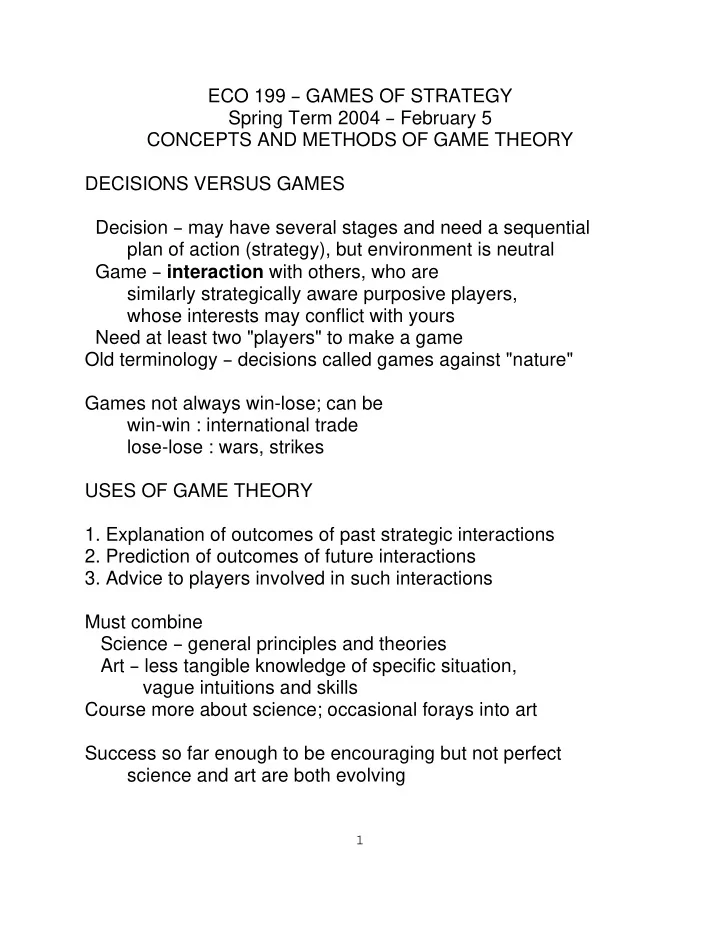

ECO 199 B GAMES OF STRATEGY Spring Term 2004 B February 5 CONCEPTS AND METHODS OF GAME THEORY DECISIONS VERSUS GAMES Decision B may have several stages and need a sequential plan of action (strategy), but environment is neutral Game B interaction with others, who are similarly strategically aware purposive players, whose interests may conflict with yours Need at least two "players" to make a game Old terminology B decisions called games against "nature" Games not always win-lose; can be win-win : international trade lose-lose : wars, strikes USES OF GAME THEORY 1. Explanation of outcomes of past strategic interactions 2. Prediction of outcomes of future interactions 3. Advice to players involved in such interactions Must combine Science B general principles and theories Art B less tangible knowledge of specific situation, vague intuitions and skills Course more about science; occasional forays into art Success so far enough to be encouraging but not perfect science and art are both evolving 1
WAYS TO STUDY GAMES 1. CASE METHOD B collection of examples indirectly convey some general principles THEORY B framework for organizing ideas We will have combination B theory through cases EMPIRICAL B Observation, Controlled Experiment We will gather and use evidence from these to sharpen understanding of theory and its limits 2. TYPES OF THEORY A. "ECONOMIC" (Rational choice and Equilibrium) Choice B Each player optimizes own preferences (must be internally logically consistent, but need not be purely selfish, or monetary, or short-run) Equilibrium B Interaction of choices mutually consistent Logical culmination of process of strategic thinking Assumption of perfect calculation can be unrealistic and equilibrium may not be attained But can learn calculation and equilibrium by playing most useful central or focal concept for analysis B. "BIOLOGICAL" (Adaptation and evolution) Limited powers of calculation and purposive choice Strategies fixed genetically or as "rules of thumb" Transmission of successful strategies genetic, and also social (learning, imitation) Eventual outcome of process B evolutionary stable outcome, also resembles equilibrium of rational choice 2
DIMENSIONS OF ANALYSIS OF GAMES 1. Moves sequential or simultaneous Different kinds of interactive thinking: Sequential: If I do this, the other will do that, then I ... Simultaneous: I think that he thinks that ... Different techniques: "trees" versus "spreadsheets" 2. Pure conflict, or some common alignment of interests Pure conflict in some sports; more generally mixed 3. One-time or repeated One-time: actions more unscrupulous, less cooperative information limited; secrecy valuable Repeated: can build up relationships and reputations can obtain and convey information can harness selfishness to achieve coop outcomes 4. Limited and asymmetric information Knowing other players’ skills, motives problematic Real game is becomes that obtaining, or conveying or concealing information 5. Rules fixed or manipulable If latter, then real game is that of manipulating the rules These are "strategic moves" B threats, promises 6. "Cooperative" or "non-cooperative" B Technical terms Cooperative B actions agreed and jointly implemented Non-coop B actions taken separately by each player Outcome can show cooperation if in private interest For example in repeated interactions 3
TERMINOLOGY AND FRAMEWORK 1. Moves and strategies Each individual instance of action is a move Strategies are complete plans of action 2. Payoffs Numerical scale B ranking, money, other things Probabilistic average (expected values) when uncertainty p 1 x 1 + p 2 x 2 + p 3 x 3 + ... 3. Rational behavior Each player has internally consistent scale of values, Can calculate and implement best action or strategy Scale can embody altruism, can internalize social norms, even emotional/angry attitudes toward unfairness etc. Can have concerns other than money, long time-horizon ... 4. Common knowledge of structure of game Structure of game B strategies, payoffs etc (or the nature of uncertainty, manipulability) Common knowledge B A knows that B knows that ... 5. Equilibrium Each player's strategy is best for him/her, taking the choices of the others as given Intended to be "stable" or "predictable" outcome but dynamics can be complex, slow, ... Theory doesn’t always work, but good enough that It should be taken as starting point of analysis Equilibrium doesn’t automatically mean "good" e.g. prisoners’ dilemma 4
Recommend
More recommend